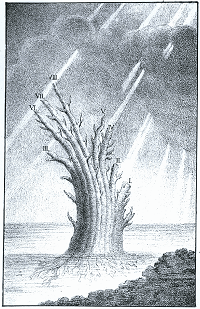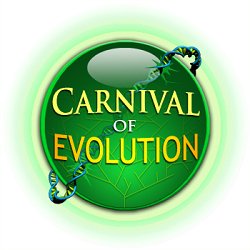I hope everyone enjoyed their holiday dinosaur this Thanksgiving, and thank you joining me in this delightful excursion out into the wide wonderful world of ideas and expressions in evolution.
Chronicle Canyon
History in the layers and controversies in the stories they tell.
How did we eradicate Malaria in the United States? A thought-provoking guest post from
Daniel Parker titled
Social Malaria, which puts forth a compelling argument that we can get a better return on our anti-malarial investment by focusing on socioeconomic factors rather than dusting Africa in DDT (Via
Anne Buchanan of
The Mermaid’s Tale).
Romeo Vitelli of
Providentia brings us a bizarre human interest story in
The Evolution of Charlotte Bach, who I can only describe as a “quack” of an evolutionary theorist who wrote numerous books, gave public talks, and hid a very dark side of her life that was only uncovered after her death.
Bradly Alicea at
Tumbld thoughts post
I was going through some of my hard-copy magazines… recreates a
SEED Magazine “field trajectory” graph for
group selection theory that ends with Nowak, Tarnita, and Wilson’s 2010
Nature publication “The evolution of eusociality” at the end of the trend and asking the reader to discuss the future trajectory of the research field.
MicroCosmos Pond
The smooth surface hides a tiny world packed with ideas.
S.E. Gould, of the
Lab Rat blog, has posted
How the animals lost their sensors, refering to the “Two Component System” (TCS) of molecular signal and response found in archaea, bacteria, eukaryotes, plants, fungi, and several protazoa–
but not animals. (Via
Bjørn Østman’s of
Pleiotropy)
From
Lucas Brouwers of
Thoughtomics comes
Animal vision evolved 700 million years ago detailing scientists on the trail of the evolutionary history of
opsin, a light-sensitive protein that makes vision possible, tracing it back to an ancient ancestor that was itself incapable of detecting light with the protein. (Via
Bjørn Østman’s of
Pleiotropy)
 Slime Molds Against a Pink Background
Slime Molds Against a Pink Background
Credit:
Alex Wild
This image is copyrighted, posted here as fair use. You can order prints of these photographs at:
Alex Wild Photography
Alex Wild of Compound Eye brings us Starving to be Social: The Odd Life of Dictyostelium Slime Molds that features a photo essay of slime molds he took from a visit to Joan Strassmann and David Queller’s lab at Washington University in St. Louis. You can also see more his spine-tingling photos and order prints at Alex Wild Photography. (Via Bjørn Østman’s of Pleiotropy)
Adaptation Ascent
A tough climb challenges your fitness.
Guest blogger at Scientific American Kate Shaw’s How Aggressive Hyena Moms Give Their Kids a Boost takes the reader through the social hierarchy of hyena clans, which she has spent countless hours studying in person, to help us understand why the females of the species are so masculinized, even having “pseudopenises that mimic male genitalia.” (Via Bjørn Østman’s of Pleiotropy)
Author
Jerry A. Coyne’s Why is one sex mimetic rather than the other? explores the question of why only the males or females of some species use mimicry to deter predators while members of the opposite sex do not. (Via
Bjørn Østman’s of
Pleiotropy)
 IAD Model
IAD Model
Bjørn Østman’s post Pleiotropy saves the day for evolving new genes explores the origin of new genes via Näsvall et al’s innovation-amplification-divergene model (IAD), where a gene “becomes pleiotropic, is copied, followed by divergence, and then loss of pleiotropy.”
Joachim of
Mousetrap presents
On testing the Red Queen hypothesis Part I and
Part 2 exploring the general Red Queen hypothesis that “hosts, parasites, predators, or competitors” are pushing species into an arms race of constant adaptation, and the problem of Hamiltonian parasites, parasites that have shorter lifespans and evolve faster than their hosts–like bacteria on an elephant, which we would expect to out-pace their hosts and kill them.
Genome Engineering’s Suzanne Elvidge’s brings us three posts this month covering recent research in genetics and evolution. Her summaries are provided.
Bringing genes and fossils together in evolutionary biology:
While the links between the study of rocks and fossils and the high-tech field of genetics are not necessarily obvious at first glance, a recent review in the Journal of Vertebrate Paleontology shows that the connection is perhaps closer than you would think. While paleontology looks at what happened in evolution, developmental genetics can help researchers to unpack how it happened, and so each discipline can feed into and support the other.
A step in the evolution of the human brain:
An international team of researchers, including researchers from China, Germany, and the University of Edinburgh in Scotland, has discovered a new piece of genetic information that could give a clue to how the human brain evolved, and what makes humans and apes different from each other.
1000 Genome Project reveals our genetic diversity:
Researchers from the 1000 Genome Project have sequenced the genomes of 1092 people from 14 ethnic groups, from Africa to Asia and from Europe to the Americas, using a combination of low-coverage whole-genome and exome sequencing. This has created what the team has described as the largest and most detailed catalogue of human genetic variation.
Disputation Pass
Don’t lose your way at this rocky intersection.
Ken Weiss from
The Mermaid’s Tale provides a very even-handed assessment of the conspiracy theories anti-evolutionists hold concerning scientists and the habits of the scientific community that sometime seem to affirm those conspiracy theories in his article
“A vast conspiracy of scientists”? Well, it depends. (Via
Randall Hayes of
Variation Selection Inheritance)
Jason Collins of
Evolving Economics blog, provides a very compelling and evidence-based critique of the Gerald Crabtree papers on the evolutionary decline of human intelligence over the last 3,000 years that has
gained so much attention in the press recently. Collins’ article, titled
The decline in intelligence?, is well worth the read if you want to understand the flaws in Crabtree’s logic. Collins’ also has a critique of
Boyd and Richerson’s Group Selection, where he confronts what he perceives as the nebulous use of “group selection” as it applies to Puritanical and cannibalistic societies used as examples in the work. (Via
Bradly Alicea of
Tumbld thoughts)
GunnarDW of
The Beast, the Bard and the Bot also provides some thoughtful challenges to Crabtree’s papers concerning the definition of intelligence and specific cognitive abilities in his article
Our Dwindling Intelligence and Einstein’s Brain.
Randall Hayes of
Variation Selection Inheritance describes his personal attempts to get his students to practice the scientific method in
The difference between screwing around and science.
Unique Overlook
Take a breather here and stretch your mind.
Via
Greg Laden, we have
A Remarkable Convergence of Species: The Deadliest Sea Snake, which previews a paper on the species
Enhydrina schistosa found through DNA evidence to be two distinct species that are remarkably alike morphologically.
 Tree of Animal Life
Tree of Animal Life
David Morrison of The Genealogical World of Phylogenetic Networks has an article up on Family trees, pedigrees and hybridization networks, illuminating the fact that a “family tree” is actually a pedigree, a hybridization network, where branches fuse at points as a result of inbreeding. He then starkly illustrates this using the family tree of the Spanish Habsburgs royal family.
While family trees are really networks, Morrison also provides many examples of Relationship trees drawn like real trees throughout history.
Bradly Alicea of
Synthetic Daisies has a post close to my heart, but rather deep to follow (I hope I don’t mangle it),
Artificial Life meets Geodynamics (EvoGeo), which covers a computer model based on a computational tool for fluid mechanics adapted for automata diffusion, adding a dynamic topology to simulate environmental changes such as those produced by plate tectonics, and finally applying a fitness function to the automata to restrict the flow of genes through the environment. It’s a fascinating project at the crossroads of evolutionary studies and computer science.
Stephen McCanny of
Ecoknowledge has an intriguing post titled
Limits of natural selection, where he explores what he perceives as “three limits to natural selection” in contributing to the origin of species, prevention of species extinction, and predicting the results of selection.
Editor’s Parking Lot
For the ride home.







Comments
4 responses to “Carnival of Evolution #54: A Walkabout Mount Improbable”